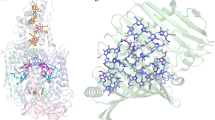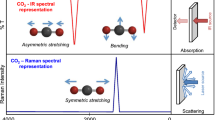Abstract
Bacteriorhodopsin is a retinal-containing protein that functions as a light-driven proton pump. Resonance Raman and femtosecond dynamic absorption spectroscopy are being used to elucidate the molecular mechanism of bacteriorhodopsin. The primary photochemical process is atrans- to-cis isomerization about the C13=C14 bond of the retinal chromophore that has been directly observed using femtosecond dynamic absorption spectroscopy. The excited state isomerization dynamics can be quantitatively analyzed using a new theory for nonstationary state spectroscopy. Resonance Raman vibrational spectroscopy has been used to determine the structure of the chromophore in each of bacteriorhodopsin’s intermediates and to analyze the kinetics of the photocycle. These results are integrated into an explicit molecular model (the C-T Model) for proton pumping in bacteriorhodopsin.
Similar content being viewed by others
References
Ames J B and Mathies R A 1990Biochemistry 29 7181
Birge R R 1990Biochem. Biophys. Acta 1016 293
Braiman M S, Ahl P L and Rothschild K J 1987Proc. Natl. Acad. Sci. USA 84 5221
Braiman M S, Mogi T, Marti T, Stern L J, Khorana H G and Rothschild K J 1988Biochemistry 27 8516
Dancsházy Zs, Govindjee R and Ebrey T G 1988Proc. Natl. Acad. Sci. USA 85 6358
Diller R and Stockburger M 1988Biochemistry 27 7641
Fodor S P A, Ames J B, Gebhard R, van den Berg E M M, Stoeckenius W, Lugtenburg J and Mathies R A 1988Biochemistry 27 7097
Hanamoto J, Dupuis P and El-Sayed M A 1984Proc. Natl. Acad. Sci. USA 81 7083
Henderson R, Baldwin J M, Ceska T A, Zemlin F, Beckman E and Downing K H 1990J. Mol. Biol. 213 899
Khorana H G 1988J. Biol. Chem. 263 7439
Kosloff R 1988J. Phys. Chem. 92 2087
Kouyama T, Nasuda-Kouyama A, Ikegami A, Mathew M K and Stoeckenius W 1988Biochemistry 27 5855
Lin S W and Mathies R A 1989Biophys. J. 56 653
Lugtenburg J, Mathies R A, Griffin R G and Herzfeld J 1988Trends Biochem. Sci. 13 388
Mathies R A, Brito Cruz C H, Pollard W T and Shank C V 1988Science 240 777
Mathies R A, Smith S O and Palings I 1987Biological applications of Raman spectroscopy (ed.) T G Spiro (New York: John Wiley and Sons) pp. 59–108
Mogi T, Stern L J, Marti T, Chao B H and Khorana H G 1988Proc. Natl. Acad. Sci. USA 85 4148
Otto H, Marti T, Holz M, Mogi T, Lindau M, Khorana H G and Heyn M P 1989Proc. Natl. Acad. Sci. USA 86 9228
Otto H, Marti T, Holz M, Mogi T, Stern L, Engel F, Khorana H G and Heyn M P 1990Proc. Natl. Acad. Sci. USA 87 1018
Pollard W T, Brito Cruz C H, Shank C V and Mathies R A 1989J. Chem. Phys. 90 199
Pollard W T, Fragnito H L, Bigot J Y, Shank C V and Mathies R A 1990aChem. Phys. Lett. 168 239
Pollard W T, Lee S Y and Mathies R A 1990bJ. Chem. Phys. 92 4012
Stern L J, Ahl P L, Marti T, Mogi T, Dunach M, Berkowitz S, Rothschild K J and Khorana H G 1989Biochemistry 28 10035
Stern L J and Khorana H G 1989J. Biol. Chem. 264 14202
Author information
Authors and Affiliations
Rights and permissions
About this article
Cite this article
Mathies, R.A. From femtoseconds to biology: Mechanism of bacteriorhodopsin’s light-driven proton pump. Proc. Indian Acad. Sci. (Chem. Sci.) 103, 283–293 (1991). https://doi.org/10.1007/BF02842085
Issue Date:
DOI: https://doi.org/10.1007/BF02842085




